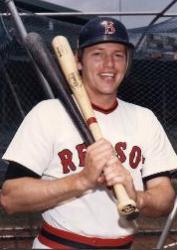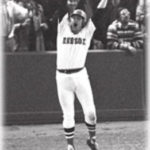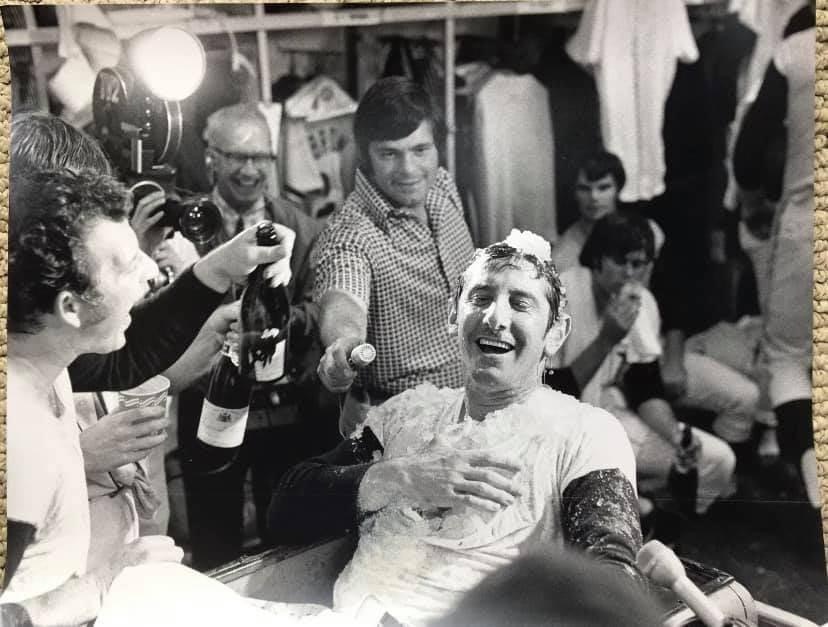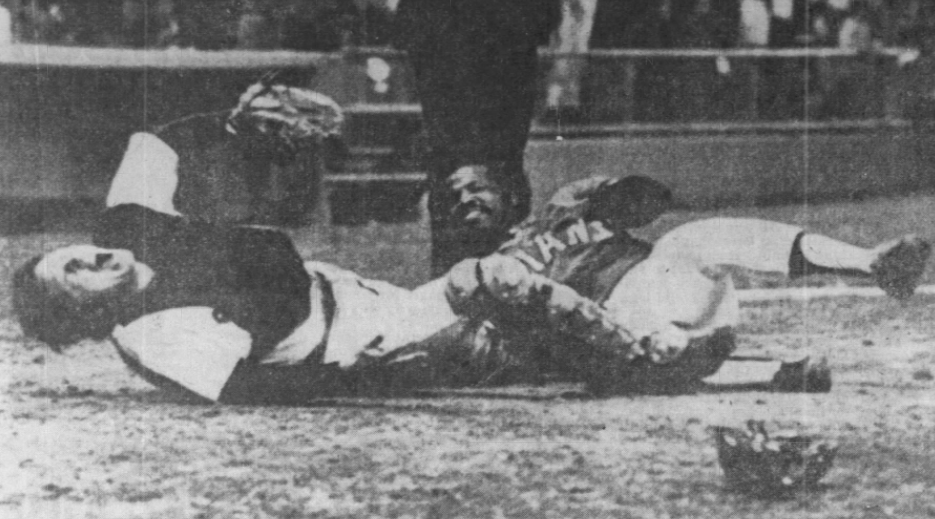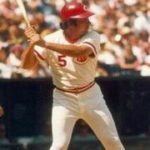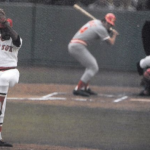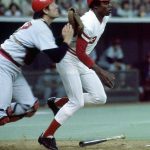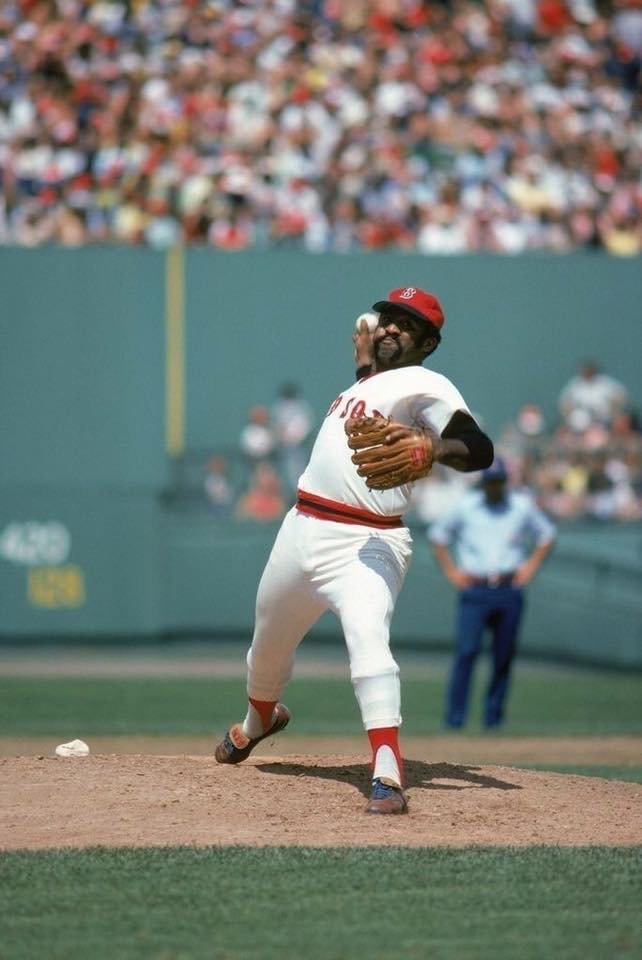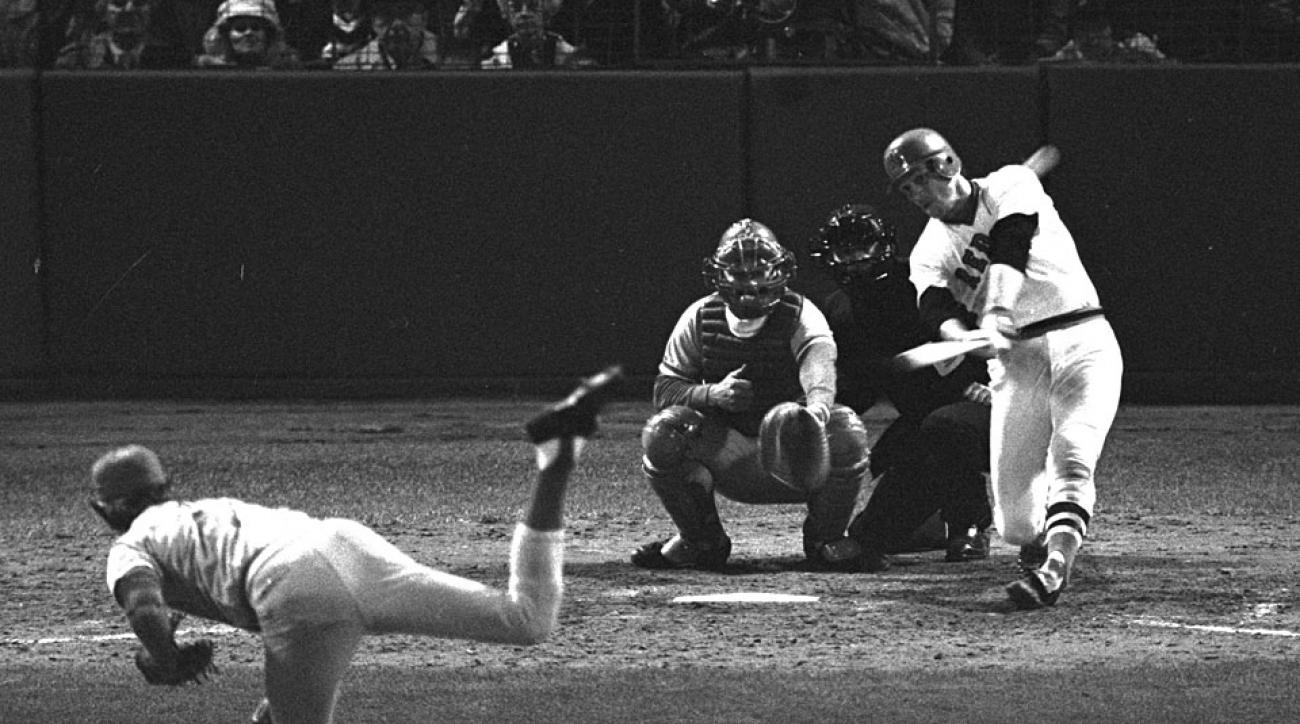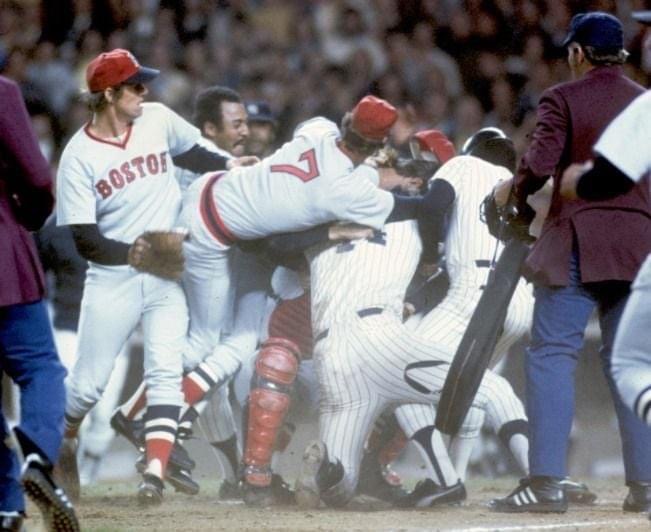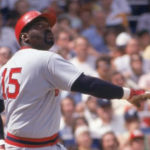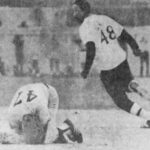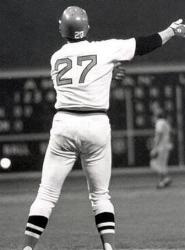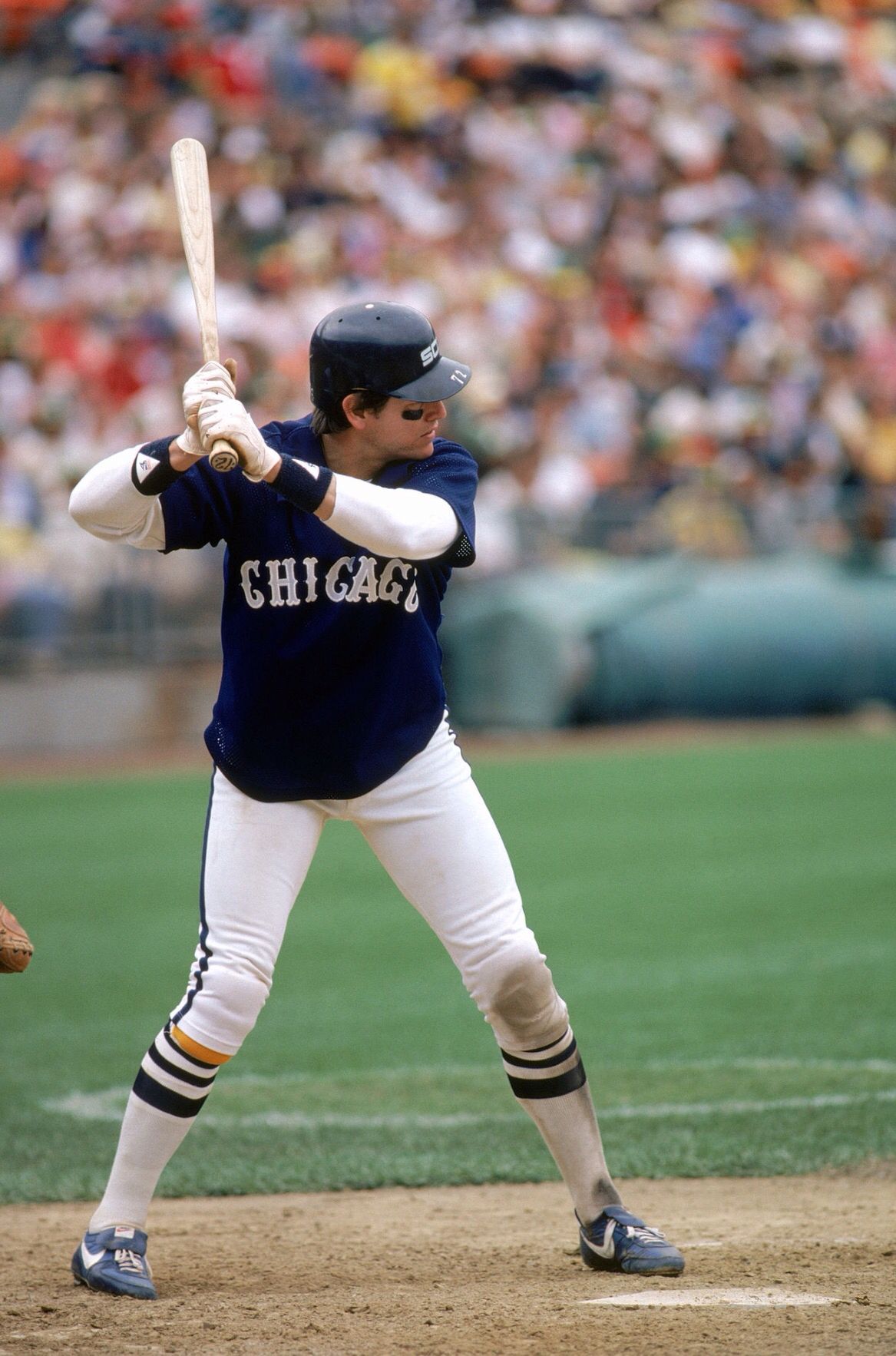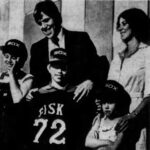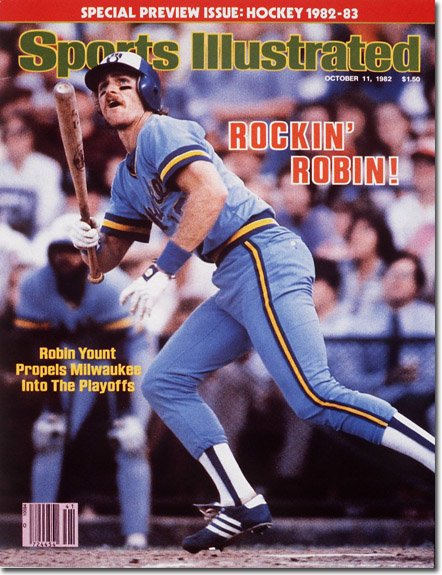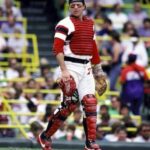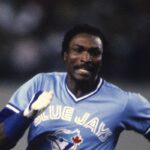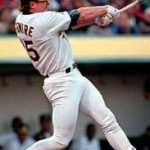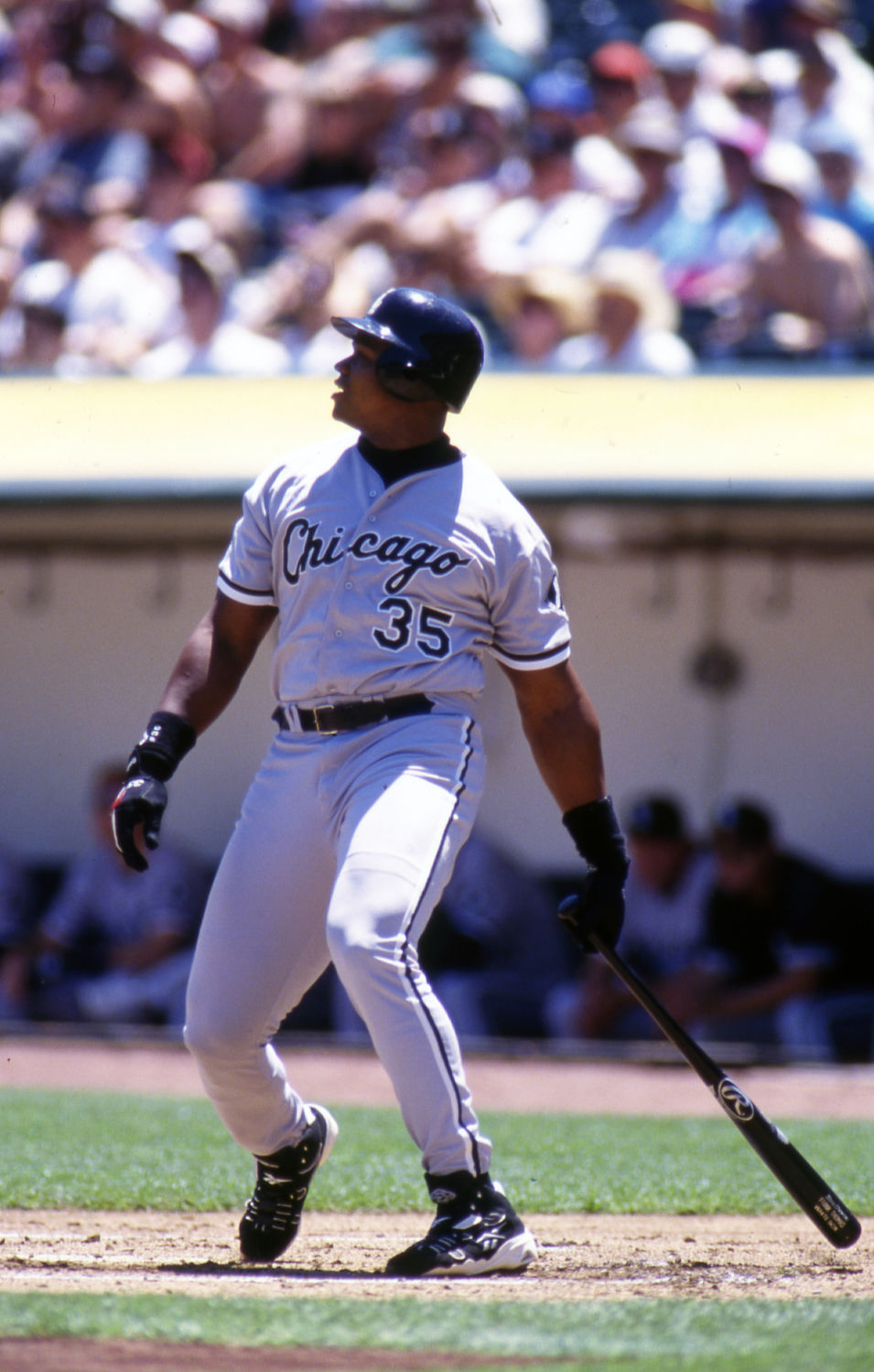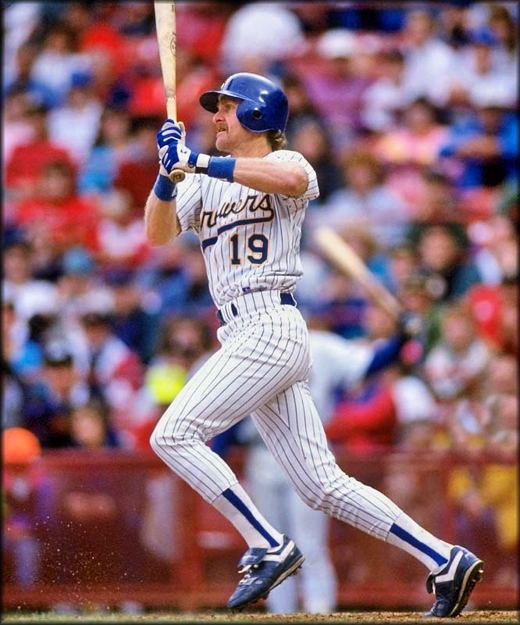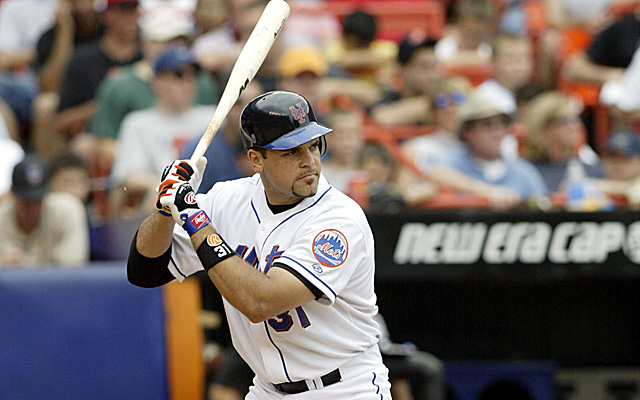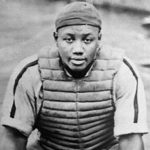Carlton Fisk Career Highlights
Carlton Fisk
Position: Catcher
Bats: Right • Throws: Right
6-3, 200lb (190cm, 90kg)
Born: December 26, 1947 in Bellows Falls, VT
Draft: Drafted by the Boston Red Sox in the 1st round (4th) of the 1967 MLB January Draft-Regular Phase.
High School: Charlestown HS (Charlestown, NH)
Schools: Keene State College (Keene, NH), University of New Hampshire (Durham, NH)
Debut: September 18, 1969 ( 10,550th in MLB history)
vs. BAL 4 AB, 0 H, 0 HR, 0 RBI, 0 SB
Last Game: June 22, 1993
vs. TEX 2 AB, 0 H, 0 HR, 0 RBI, 0 SB
Hall of Fame: Inducted as Player in 2000. (Voted by BBWAA on 397/499 ballots)
View Carlton Fisk’s Page at the Baseball Hall of Fame (plaque, photos, videos).
Full Name: Carlton Ernest Fisk
Nicknames: Pudge
View Player Bio from the SABR BioProject
Nine Other Players Who Debuted in 1969
Darrell Evans
Bill Buckner
Carlton Fisk
Steve Garvey
Bill Russell
Toby Harrah
Vida Blue
Jerry Reuss
Thurman Munson
The Carlton Fisk Teammate Team
C: Joel Skinner
1B: Carl Yastrzemski
2B: Steve Sax
3B: Robin Ventura
SS: Ozzie Guillen
LF: Jim Rice
CF: Fred Lynn
RF: Harold Baines
DH: Frank Thomas
SP: Luis Tiant
SP: Bill Lee
SP: LaMarr Hoyt
SP: Floyd Bannister
SP: Jack McDowell
RP: Bobby Thigpen
RP: Bill Campbell
M: Tony Larussa
Notable Events and Chronology for Carlton Fisk Career
One of the finest catchers in American League history, Carlton Fisk spent more years behind the plate (24) than any other A.L. receiver. The New England native also held at one time major league records for most home runs by a catcher (351), most stolen bases (128), and most games caught (2,226). Fisk remains one of only three catchers in baseball history to hit 300 home runs, scoring 1,000 runs, and drive in 1,000 runs, joining Johnny Bench and Yogi Berra on an extremely exclusive list. An 11-time All-Star, Fisk hit more than 20 home runs eight times, knocked in more than 100 runs twice, batted over .300 twice, and scored more than 100 runs once, earning in the process four top-ten finishes in the league MVP balloting. In spite of his outstanding career accomplishments, though, Fisk is remembered as much as anything for his game-winning home run in Game Six of the 1975 World Series – a blast generally considered to be one of the most famous in the history of the Fall Classic.
Born in Bellows Falls, Vermont on December 26, 1947, Carlton Ernest Fisk acquired the nickname “Pudge” as a result of the stocky frame he carried with him throughout his youth. After graduating from Charlestown High School in New Hampshire, Fisk attended the University of New Hampshire on a basketball scholarship, hoping to one day fulfill his dream of playing for the Boston Celtics. While still just a sophomore at New Hampshire, though, Fisk was selected by the Boston Red Sox with the fourth overall pick of the 1967 amateur draft. After spending the next three years advancing through Boston’s farm system, the 21-year-old catcher received his first major league call-up late in 1969, appearing in just two games for the Red Sox before being returned to the minors for more seasoning. Fisk split his time in 1970 and 1971 between catching in the minor leagues and fulfilling his military obligations, finally rejoining Boston during the final month of the 1971 campaign. Acquitting himself extremely well in the 14 games in which he appeared, Fisk batted .313 and hit his first two major league home runs.
His confidence buoyed by his outstanding performance the previous September, Fisk established himself as Boston’s starting catcher in 1972. The 24-year-old receiver hit 22 home runs, knocked in 61 runs, scored 74 others, led the league with nine triples, and batted .293, en route to becoming the first player ever to win the Rookie of the Year Award unanimously. Fisk also won the only Gold Glove Award of his career, earned All-Star honors, and placed fourth in the A.L. MVP voting, while quickly developing into one of Boston’s team leaders. A fierce competitor and an outspoken proponent of always putting forth a 100 percent effort, the rookie catcher chastised star outfielders Carl Yastrzemski and Reggie Smith for not hustling at times. He also did an exceptional job of handling Boston’s veteran pitching staff, helping the Red Sox finish a close second in the A.L. East after the team had been mired in mediocrity the previous four years.
Fisk suffered through a slightly subpar 1973 season, batting only .246 and striking out a career-high 99 times, despite hitting 26 homers and driving in 71 runs. It was during that 1973 campaign that one of the American League’s fiercest individual rivalries was born, and that one of the sport’s most intense team rivalries was rekindled.
New York Yankee catcher Thurman Munson captured A.L. Rookie of the Year honors just two years before Fisk won the trophy. Since Munson and Fisk were the junior circuit’s top two receivers, a strong sense of competition naturally developed between them. The young catchers felt additional enmity towards each other because they played for two of the American League’s oldest rivals. Munson, in particular, resented Fisk because he believed that national TV announcer Curt Gowdy, who had his broadcasting roots in Boston, spent a considerable amount of time glorifying Fisk’s accomplishments at the New York receiver’s expense.
The matter came to a head on August 1, 1973 at Fenway Park. With the score tied at 2-2 in the top of the ninth inning and Munson occupying third base, New York attempted a suicide squeeze. When teammate Gene Michael failed to make contact with the pitcher’s offering, Munson tried to knock the ball out of Fisk’s glove by barreling into him as he approached home plate. The collision between the two men initiated a 10-minute bench-clearing brawl in which both catchers were ejected. Munson and Fisk held a begrudging respect for one another in subsequent seasons, but ill feelings continued to exist between them until the former was killed in a 1979 plane crash.
Fisk continued to rival Munson as the American League’s top receiver the next several years even though he missed an extensive amount of playing time due to injuries. A foul tip off the bat of Joe Torre in a 1974 spring training game injured his groin, causing him to miss the first three weeks of the season. Fisk then sat out the entire second half of the year with a seriously injured knee suffered during a home-plate collision with Cleveland’s Leron Lee. Having recovered from reconstructive knee surgery during the offseason, Fisk missed the first half of the 1975 campaign after having his thumb broken by an errant pitch from Detroit’s Fred Holdsworth in spring training. However, the Boston catcher returned to the team in late June to help the Red Sox reach the World Series by batting .331 and driving in 52 runs in 79 games.
The 1975 World Series served as the backdrop for the defining moment of Fisk’s Hall of Fame career. Considered by many to be the most dramatic game in the history of the Fall Classic, Game Six turned into a see-saw affair that featured several exceptional plays by both sides. With Cincinnati ahead in the Series three-games-to-two, the score remained tied 6-6 heading into the bottom of the 12th inning. Leading off the bottom of the frame against Reds hurler Pat Darcy, Fisk drilled the righty reliever’s second pitch high and deep down the left field foul line. The image of Fisk jumping up and down as he attempted to wave the ball fair while he headed towards first base remains vivid in the minds of most baseball fans who witnessed the event. The ball struck the foul pole, giving the Red Sox a 7–6 win and forcing a seventh and deciding game that Cincinnati eventually won.
Recalling his memorable blast, Fisk noted, “I knew it was gonna’ go out. It was just a question of it being fair or foul. The wind must have carried it 15 feet toward the foul pole. I just stood there and watched. I didn’t want to miss seeing it go out.”
Fisk added, “And then after that, running around the bases, it was just one of those things. You couldn’t believe what happened to you. And I look back on it, it’s almost like it happened to somebody else.”
Squabbles with Boston management over a new contract led to an off year by Fisk in 1976, but he rebounded in 1977 to have arguably his best all-around season. Starting 149 games behind the plate for the Red Sox, Fisk hit 26 home runs, knocked in 102 runs, batted .315, and established career-highs with 106 runs scored and a .402 on-base percentage, en route to earning an eighth-place finish in the league MVP voting. The Boston receiver placed in the top ten in the balloting again the following year when he helped lead his team to a first-place tie in the American League East during the regular season with the New York Yankees. Although the Yankees won the division in a one-game playoff, Boston’s close second-place finish and Fisk’s 20 homers, 88 RBIs, 94 runs scored, and .284 batting average enabled him to place ninth in the MVP voting.
A rib injury limited Fisk to just 91 games in 1979, but he returned to Boston’s starting lineup full time the following year to hit 18 homers, drive in 62 runs, and bat .289. The 1980 campaign turned out to be Fisk’s final one in Boston. After the Red Sox front office blundered by failing to postmark his new contract in time, Fisk technically became a free agent at the conclusion of the 1980 season. He subsequently signed a $3.5 million deal with the Chicago White Sox, with whom he spent the remainder of his career.
After performing well for Chicago his first two years with the team, Fisk helped lead a young White Sox squad to the first A.L. West title in franchise history in 1983. The catcher’s 26 home runs, 86 runs batted in, 85 runs scored, .289 batting average, and tremendous on-field presence earned him a third-place finish in the league MVP voting. Noted for his ability to handle a pitching staff, Fisk took control of Chicago’s young crop of hurlers that included A.L. Cy Young Award winner LaMarr Hoyt. Also notorious for making an inordinate number of trips to the mound over the course of a game, Fisk once prompted opposing manager Bobby Valentine to wonder out loud if the White Sox were being paid by the hour.
Games that Fisk spent behind home plate may have taken a bit longer to complete, but the end results were all that mattered. Fisk served as Chicago’s primary catcher when Bobby Thigpen established a new record for most saves in a season, with 57 in 1990. He also helped develop Jack McDowell, who won the Cy Young award in 1993. Luis Tiant, who pitched to dozens of backstops in his day, worked with Fisk in Boston for several seasons. The man known as El Tiante said flatly, “He (Fisk) was the best catcher I ever had.”
Injuries once again befell Fisk in 1984, limiting him to just 102 games and a .231 batting average. Although he also hit 21 home runs, Fisk knocked in only 43 runs – the lowest RBI total ever compiled by a player who reached the 20-homer mark. The catcher’s injury-marred 1984 campaign caused him to begin a new training regimen, which he used the remainder of his career. Fisk later credited White Sox strength and conditioning coach Phil Claussen for helping him extend his career. Claussen introduced Fisk to a more scientific approach to physical conditioning that included long sessions of weight training.
Standing close to 6’3” and weighing approximately 220 pounds throughout most of his career, Fisk appeared in better shape than ever before when he reported to spring training in 1985. After working extensively with Claussen during the offseason, Fisk appeared in a total of 153 games for the White Sox, 120 of which he started behind the plate. The additional muscle tacked on by the 37-year-old receiver enabled him to establish new career highs with 37 home runs and 107 runs batted in, although he batted only .238. Fisk also stole a career-best 17 bases.
Although he never again put up huge offensive numbers, Fisk remained a productive hitter for most of his final eight seasons in Chicago. After hitting 23 home runs and knocking in 71 runs the previous year, he batted .277, hit 19 homers and drove in 50 runs in only 76 games as a 40-year-old in 1988. Fisk missed the first two months of 1989 with a broken hand, but he returned to the White Sox in June to hit 13 home runs, knock in 68 runs, and bat .293 in 103 games. The catcher had another solid year in 1990, but he became a part-time player in his final two seasons after hitting just .241 in 1991. Still, Fisk continued to contribute to the White Sox with his deft handling of pitchers and his exceptional leadership skills. Admired and respected by teammates and opponents alike for his tremendous pride and work ethic, Fisk drew praise from former White Sox manager Jim Fregosi, who stated, “Pudge works harder than anyone I know, because he sets goals for himself and then follows through. I think he’s the ultimate professional.”
Fisk’s work ethic and professionalism was such that he refused to settle for anything less than a 100 percent effort, even from the opposition. In a highly-publicized incident that occurred in May 1990, Fisk screamed at New York Yankee rookie Deion Sanders for failing to hustle to first base on a popup. When Sanders arrived at the plate for his next at-bat, Fisk warned him, “If you don’t play it (the game) right, I’m going to kick your ass right here.” Following the contest, the veteran catcher scoffed, “Yankee pinstripes, Yankee pride…I’m playing for the other team, and it offended me.” Sanders ended up apologizing the next day.
In a move that ended Fisk’s relationship with the White Sox organization for many years, he was unceremoniously released by the team midway through the 1993 campaign, just days after setting a new record for most games caught. Chicago won the division later that year but refused to allow Fisk to enter the clubhouse to congratulate his teammates of just a few months prior. Fisk ended his playing career with 376 home runs, 1,330 runs batted in, 1,276 runs scored, 2,356 hits, and a .269 batting average.
Fisk gained induction into the Hall of Fame in 2000, in just his second year of eligibility. Displaying the anger he still felt towards Chicago management, he chose the Boston Red Sox cap for his plaque, even though he spent more years with the White Sox.
@ET-DC@eyJkeW5hbWljIjp0cnVlLCJjb250ZW50IjoicG9zdF90YWdzIiwic2V0dGluZ3MiOnsiYmVmb3JlIjoiTGVhcm4gTW9yZSBhYm91dCB0aGUgdGVhbXMsIHBsYXllcnMsIGJhbGwgcGFya3MgYW5kIGV2ZW50cyB0aGF0IGhhcHBlbmVkIG9uIHRoaXMgZGF0ZSBpbiBoaXN0b3J5IC0gLSAtIC0gLSAtIC0gIiwiYWZ0ZXIiOiIiLCJsaW5rX3RvX3Rlcm1fcGFnZSI6Im9uIiwic2VwYXJhdG9yIjoiIHwgIiwiY2F0ZWdvcnlfdHlwZSI6InBvc3RfdGFnIn19@
Factoids, Quotes, Milestones and Odd Facts
A unanimous Rookie of the Year selection in 1972, the studious Carlton Fisk was at times the best catcher in the American League during the 1970s and 1980s. He hit one of the most dramatic home runs in post-season history, winning Game Six of the 1975 World Series for the Red Sox. With the White Sox he set single-season and career records for homers by a catcher, as well as games caught in a career. He was elected to the Hall of Fame in 2000.
Played For
Boston Red Sox (1969-1980)
Chicago White Sox (1981-1993)
Similar: Gabby Hartnett
Linked: Al Lopez, Ray Schalk, Bob Boone, Thurman Munson, Lance Parrish, Johnny Bench, Gary Carter, Mike Piazza… Ed Armbrister, utility man for the Reds, who collided with Fisk in Game Three of the 1975 World Series after a bunt. Fisk was charged with catcher’s interference in a controversial play… Yankee rookie Deion Sanders, who got an earful from Pudge when he failed to run out a ground ball.
Nicknames: “Pudge”
Uniform #: Fisk wore the number 27 with the Red Sox, and when he was signed by the White Sox he decided to have a new start. He turned the number around and also said at the time that he was honoring his rookie season by wearing #72.
Best Season, 1977
With Fisk, like most catchers, it’s difficult to select a best season. In 1977 he was younger and an excellent overall hitter, but not the power hitter he became later with the White Sox. He hit a career-high (min. 100 games) .315 in 151 games behind the plate. He hit 26 homers and drove in 102 runs, both career-bests until his 1985 season (37-107 at the age of 37). Fisk didn’t win Gold Glove awards (only one) in the 1970s because Thurman Munson had the reputation of being a better handler of pitching staffs (which he probably was not), and Jim Sundberg was in the league.
Awards and Honors
1972 AL Gold Glove
1972 AL Rookie of the Year
Post-Season Appearances
1975 American League Championship Series
1975 World Series
1983 American League Championship Series
Description
Fisk was one of the most interesting characters of his era. He marched to the beat of his own drummer. While with the Red Sox he earned a reputation as a tough competitor and clubhouse lawyer. In both Boston and Chicago he clashed with his GM and owners, and he was involved in the collusion case against baseball in the late 1980s. In that case, free agents like Fisk and Kirk Gibson charged that owners had conspired to limit free agent movement. The players won in a slam dunk and Fisk emerged even more bitter and suspicious.
As a player, Fisk walked like an 85-year old man, even when he was in his twenties. He was very concerned with his appearance, and he took as much time as any batter in preparing to hit. He once walked so slow to the mound to talk to his pitcher, that Rangers’ manager Bobby Valentine wondered if he was “paid by the hour.”
Fisk looked out of place in a baseball uniform, which was strange considering he was a throwback competitor. He wore his pants very high, showing off his socks, be they red, white, or whatever color. With the Pale Hose he lived through six or seven uniform changes, looking like a grizzled veteran in all of them.
Fisk considered himself a protector of the game’s honor. On numerous occasions he challenged teammates for failing to play the game properly or (worst of all) failing to hustle. In a celebrated incident, he nearly came to blows with the entire New York team after he admonished Yankee rookie Deion Sanders for failing to run out a routine grounder. Shocked by the confrontation, Sanders later apologized for his actions.
At the end of his career, Fisk had proved most of his critics and skeptics wrong, playing more games than any other catcher in baseball history, despite injuries (many of them before the age of 30), having to fight for playing time, and a tall frame that took abuse. Over 24 seasons, his back and knees held up pretty well and he caught his last game at the age of 45. He was the Nolan Ryan of the catching profession.
Where He Played: Catcher; After blasting 37 homers in 1985, the ChiSox tried to make Fisk a left fielder, to make room for young catching prospect Joel Skinner. By May, the experiment was over and Fisk was back behind the mask. Skinner was traded to the Yankees and was out of baseball by his 30th birthday, three years before Fisk retired.
Feats: No catcher has caught as many games (2,226) or hit as many homers while playing the position (351)… In 1985, Fisk hit 37 homers, 33 of them while a catcher, breaking Lance Parrish’s AL mark for homers by a backstop.
Notes
Fisk gave one of the longest speeches in Hall of Fame history on his induction day.
Hitting Streaks
18 games (1976)
Transactions
January 28, 1967: Drafted by the Boston Red Sox in the 1st round (4th pick) of the 1967 amateur draft; February 12, 1981: Granted Free Agency; March 18, 1981: Signed as a Free Agent with the Chicago White Sox; November 12, 1985: Granted Free Agency; January 8, 1986: Signed as a Free Agent with the Chicago White Sox; January 22, 1988: Granted Free Agency; February 9, 1988: Signed as a Free Agent with the Chicago White Sox; November 4, 1991: Granted Free Agency; December 11, 1991: Signed as a Free Agent with the Chicago White Sox; December 19, 1992: Granted Free Agency; February 5, 1993: Signed as a Free Agent with the Chicago White Sox; June 28, 1993: Released by the Chicago White Sox. The Sox lost Fred Lynn in the same manner.
In a monumental blunder, the Red Sox failed to tender Fisk a contract on time during the 1980 off-season, which resulted in his becoming a free agent. Having already battled the team on contract issues, Fisk quickly signed with the White Sox.
Fisk vs. Reinsdorf
Fisk had several skirmishes with White Sox management. He was never fond of owner Jerry Reinsdorf, who tried to trade the popular catcher, move him from behind the plate, and control Pudge’s free agent status. In 1986, Reinsdorf colluded with other owners to keep Fisk and other free agents from moving to new teams or getting fair contracts. When Fisk approached the all-time games caught record late in his career, Fisk battled with the Sox to allow him to play. A week after breaking Bob Boone’s mark, Fisk was released by Chicago, and at the end of the season, after his teammates clinched the AL West title, he was not allowed into the clubhouse to congratulate them. When the White Sox planned a ceremony to honor Fisk and retire his #72, the future Hall of Famer insisted that Reinsdorf and GM Ron Schueller not be present. His Hall of Fame plaque shows him wearing a Boston cap, one last shot at his troubled years in the Windy City.
All-Star Selections
1972 AL
1973 AL
1974 AL
1976 AL
1977 AL
1978 AL
1980 AL
1981 AL
1982 AL
1985 AL
1991 AL
Replaced
Duane Josephson and Bob Montgomery, who shared the ctahing duties for the BoSox in 1971.
Replaced By
Ron Karkovice
Best Strength as a Player
Competitiveness
Largest Weakness as a Player
None
Other Resources & Links
Coming Soon
If you would like to add a link or add information for player pages, please contact us here.

